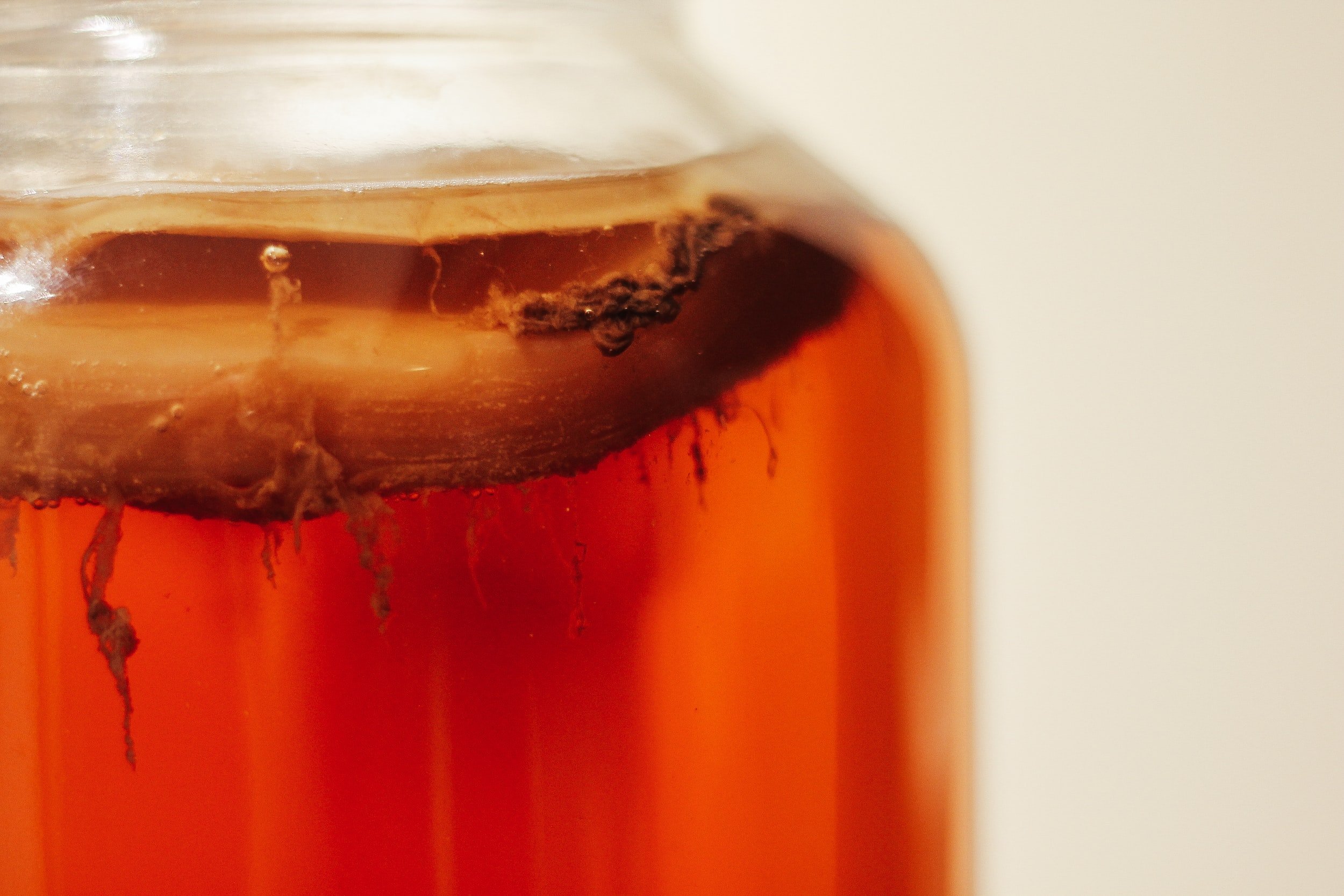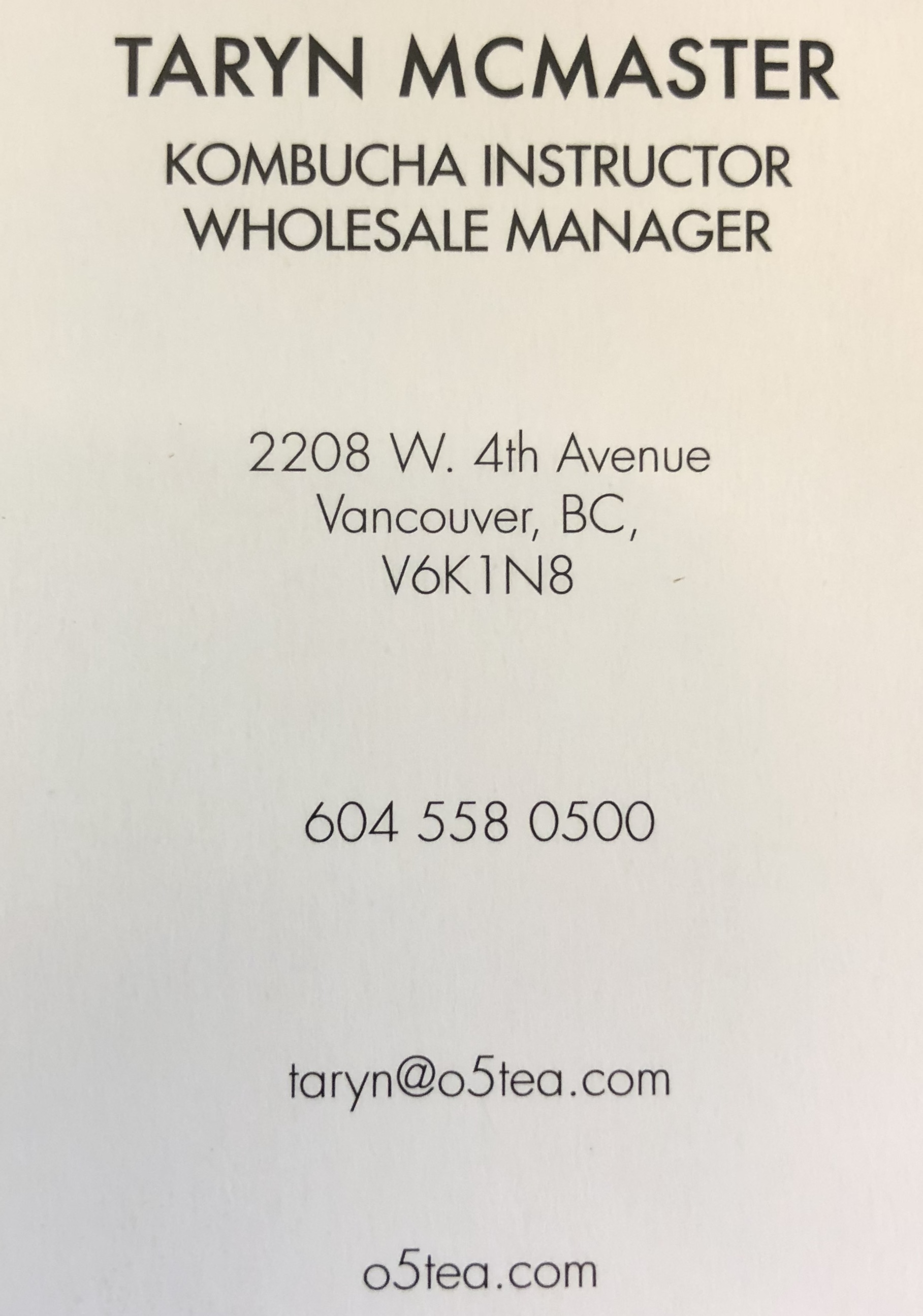7 Amazing Health Benefits of Kombucha: and an Interview with a Brewer
You’ve probably heard of a doggy mama, or perhaps a fur mama. But have you ever heard of a “SCOBY mama”???
I have, and I’d like you meet her. Her name is Taryn and I recently had the pleasure of sitting down with her to ask some questions about how to brew your own kombucha.
What Exactly is Kombucha?
Many of you have probably heard of kombcha. You may have even had the occasional glass. But what exactly is it, what benefits does it provide, and why might you just want to give it a try?
7 Amazing Health Benefits of Drinking Kombucha
1. Improved Digestion
First and foremost, kombucha is alive. It contains beneficial bacteria and cultures that help repopulate the healthy bacteria and yeasts in our gut microbiome. The combination of beneficial bacteria (or probiotics), live enzymes, and organic acids can improve digestion, soothe an upset stomach, and provide relief from (and possibly even prevent) digestive issues such as IBS, constipation, and a leaky gut.
2. Strengthened Immunity
The antioxidants and probiotics in kombucha are anti-inflammatory. As inflammation lies at the root of most illness, reducing it can improve overall health, strengthen the immune system and even prevent some illnesses from taking hold.
3. Improved Liver Health and Detoxification
Once again, the antioxidants in kombucha can help protect the liver from oxidative stress. This is especially important for digestion and overall health, as the liver is the body’s main filtering organ. As such, it is responsible for removing harmful substances from the blood, rendering them useless. In addition, the beneficial bacteria and yeasts in kombucha will help crowd out and cut off harmful ones, like candida.
4. Improved Mental Health
As we now know, the beneficial bacteria in kombucha encourages a healthy gut microbiome. What you may not know is that the gut is considered our “second brain”. That means the health of our gut contributes more than we may realize to the health of our brains, especially by improving mood and relieving anxiety or depression. Since the majority of serotonin, your body’s mood stabilizing hormone, is produced by your gut, keeping your gut healthy and well-populated with beneficial bacteria can help improve your overall mental health.
5. Maintains a Healthy Heart
Though research in this area has been limited, kombucha is considered beneficial for circulation and the heart. It may also very well help lower blood fats and regulate cholesterol levels. The iron and B vitamins created from the black tea during fermentation can help oxygenate the blood and body tissues, including the heart, while boosting energy at the same time.
6. Antibacterial Protection
The type of bacteria found in kombucha (the live cultures) works to destroy the bacteria responsible for causing certain infections. Most notably, kombucha seems to have antibacterial effects against E. coli, staph, and some strains of salmonella. If this isn’t a good enough reason to drink it, kombucha can also help prevent the growth of cancer cells. The polyphenols, antioxidants, and vitamin C in the tea protect our bodies from oxidative stress, inflammation, tumours, and various cancers.
7. Weight Loss
Since kombucha is high in probiotics, polyphenols, and acetic acid (similar to apple cider vinegar), it can help with weight loss by speeding metabolism, improving digestion, and increasing nutrient absorption. The acetic acid may also help lower blood sugar and insulin levels. Be cautious about the sugar content of kombucha, however, as it can vary from 2-7grams per serving. Though this is quite low compared to soda, be sure to check labels for the lowest sugar content kombucha, as it can add up quickly. Better still, make it yourself!
If you are interested in drinking kombucha on a more regular basis (as I suggest you do), you may be shocked to discover how costly it can be. Ranging from $3 - $5 a bottle, as a regular purchase, this may become “hard to swallow”.
That’s why I suggest you try brewing your own for the freshest kombucha with the most active enzymes and ingredients. As I have come to discover, it’s actually a fairly simple process. You just need to maintain very clean standards and keep your ‘bucha brew away from other foods you may be fermenting or your compost bin - the last thing you want is the cross contamination of undesirable bacteria mixing with the good stuff!
So how do you start? First, you must source a ‘SCOBY’ from another brewer or a great place that makes (and sells) their own kombucha.
This brings me to my interview with Taryn and how I came to brew my own kombucha.
Interview with a Kombucha Brewer
Let me begin with my discovery of a fantastic rare tea bar in Vancouver, BC, called o5tea. About a year back, my husband and I wandered into the shop in Kitsilano and quickly ended up engrossed in a conversation with the owner, Pedro. He discussed his most recent trips to Japan, the various tea harvesters that supply his shop, and how he sources some of the finest teas in the world. He also schooled us on matcha and various green teas (the benefits of which will be explored in a future blog post).
Throughout this discussion and the many teas that we sampled, Joe discovered his new favourite matcha, and I discovered my new favourite kombucha bar!
Ever since that very first day, we were hooked.
Now, any time we visit Vancouver we make a point of spending some time at o5’s tea bar. The tea sommeliers have come to know us by now, and remember what we like. Their daily suggestions, based on our previous history, have always been spot on.
On a recent trip to Vancouver in January, and our obligatory stop at o5, we inquired about the classes they offer on brewing your own kombucha. Luckily for us, one of their upcoming classes corresponded to a weekend we were to be in Vancouver. It was unanimous - we decided to attend.
It was there I met Taryn.
Taryn McMaster is o5tea’s wholesale manager and kombucha instructor - or “SCOBY mama” as she calls herself (though I think “Kombucha Brew Master” may be more appropriate).
I then had the opportunity to interview her and pick her brain about the brewing process so that I could pass her knowledge on to my readers.
Here was our interview:
Q: Let’s start with the basics - What exactly is kombucha and from where did it originate?
A: Kombucha is fermented tea, and the origin is unknown. There are a lot of different theories online, but when it boils down to it, no one really knows.
Q: What does SCOBY stand for?
A: Symbiotic Culture (Compound/Colony) Of Bacteria and Yeast.
Q: How did you get into kombucha making?
A: Through my desk job, as odd as that is!
I work as the wholesale manager for O5 during the week and was offered the opportunity to teach these classes before I had ever made a batch of my own, which I’ll admit was completely terrifying at the time.
After watching the owner of O5, Pedro, teach a couple of classes, I did some personal experimentation and asked a LOT of questions. I quickly came to realize how easy the process is and started to teach classes in September of 2016.
Q: What are the components needed to make kombucha?
A: Tea, sugar and a SCOBY!
For tea, you want to use something that tastes delicious to you (the most important part of the process in my opinion) as long as it’s not too oily. Avoid teas like rooibos and earl grey as their oils can negatively affect your SCOBY.
Contrary to what you may read online, tisanes such as peppermint or dok anchan are great for making kombucha too!
When selecting a sugar, you can use pretty much anything as long as it is not a zero-Calorie sweetener.
YES: Cane sugar, honey, maple syrup, coconut sugar, molasses, agave.
NO: Stevia, Truvia, Splenda.
“Note: if you choose to use raw honey, be aware that you may end up with a proliferation of yeast. This yeast build-up can result in excess alcohol production, but can be fixed simply by bathing your SCOBY in water or white vinegar to rinse off the stringy brown yeast buildup, or doing a couple of batches using sugar (organic cane sugar is best) to balance things out again.
”
Q: What is the difference between kombucha and jun?
A: Kombucha = Black tea + sugar | Jun = Green tea + honey. The brewing process looks largely the same, though your fermentation times may vary.
Q: If someone was thinking about starting to brew their own kombucha, what advice would you give them?
A: On the off chance something does go wrong, I always recommend keeping a backup SCOBY.
As you make kombucha, your SCOBY will eventually grow into layers. These layers will naturally separate along the edges and should be fairly easy to pull apart (if they aren’t, your SCOBY isn’t ready to split yet). You can save your new SCOBY for later by storing it in some kombucha from your most recent batch in an airtight container in the fridge.
Q: What are the 3 most important things anyone wanting to start brewing their own kombucha should know?
A:
Fruit Flies love kombucha, so watch out - especially in warmer months!
Kombucha fermentation is done with an open lid to encourage the production of acetic acid (vinegar) as opposed to ethanol (alcohol). That said, you need to cover your brew with a cloth that will not let fruit flies in!
The best, most cost-effective solution I’ve found is a coffee filter secured with a rubber band.
If the tea tastes bad to you, the kombucha likely will too.
By no means am I suggesting that you need to run out and buy the most expensive tea on the market to have a delicious brew. Some of my favourite batches have come from extremely budget-friendly teas.
You want to have a tea that tastes great to you, and if it doesn’t, introducing a SCOBY usually won’t correct the problem.
Follow a recipe in the beginning and get creative only after you’ve nailed the basic brew.
It can be super fun to play with flavouring and recipe variations, but if something goes wrong it’s much easier to determine what the cause was when working from a recipe.
Q: What are the health benefits of kombucha?
A: At O5, we believe in drinking kombucha because it is delicious - anything else is just a bonus.
For me, a delicious cup of kombucha makes me happy, and I believe happiness contributes to overall well-being 😊
Q: What is your favourite kind of tea to use? Why?
A: Oh, I could never choose just one!
I recently did a “special edition” batch of Kombucha using Balhyocha Noeul (a Korean oolong which also happens to be my favourite tea) to sell at the tea bar… and it was amazing, but the price point just wasn't realistic to keep it as a regular brew.
I think that there can be a close connection between flavour and feeling or mood, so during the warmer months I usually opt for green or white teas for a crisp, refreshing, and bright taste.
During the cooler months, I might opt for a black, roasted or highly oxidized oolong tea.
Q: What is the best way to flavour kombucha?
A: I like to play with bitters (yes, the ones used in cocktails) as they are easy and convenient, and you can flavour by the glass.
Unlike doing a secondary fermentation to infuse the flavours like lemon and ginger, there is no additional time needed when flavouring with bitters.
Q: What is your favourite flavour combination?
A: I love a good white tea and honey kombucha, particularly in the warmer months. Thanks to their sweet and gentle flavour profiles, white teas tend to pair well with almost any secondary flavouring.
A colleague of mine got me hooked on pairing celery bitters with white tea kombucha and the result is unreal. So so good.
Q: How do you control the amount of carbonation in your home brew?
A: To get carbonated kombucha at home, you need to do a process called “bottle conditioning”.
Once your kombucha is finished and you love the taste, put your kombucha into a sturdy bottle (I recommend a glass growler with a metal twist cap, 1L or smaller) filled 0.5-1 inch from the top.
Leave the bottle on the counter for 2-4 days (I check on mine every second day, and if I hear a satisfying ‘tssssss’ when I start to open the lid, I know that it’s ready).
So what's actually happening?
The bacteria and yeast from your SCOBY are still present in the kombucha, and when stored at room temperature they will continue to produce CO2. The sealed growler traps the gases inside, and eventually they are forced back down into the liquid, thereby carbonating it.
Last step: Place your kombucha in the fridge to avoid the development of ethanol [which happens when it’s] stored at room temperature.
Q: What have you found scares people the most from trying their own brew?
The not so scary SCOBY!
A: The SCOBY!
I think people look at it, and because they’ve never seen one before, they think it’s going to be impossible. They think the chubby-little-alien-thing will require way more maintenance than it really does.
SCOBYs are really easy to take care of, and if ever you need a break [from kombucha brewing], simply store your SCOBY in kombucha from your most recent batch in an airtight container in the fridge.
Q: Is there anything else you would like people to know?
A: Kombucha is easy to make at home, and that’s coming from someone who managed to kill a cactus last year.
(Hey - we have that in common!)
You can do it!
Q: One last question so people can get to know you personally, when you are not managing o5’s wholesale department or teaching kombucha classes, what do you like to do for fun?
A: I am a singer! I studied Contemporary Music & Technology at Selkirk College right out of high school, and upon my return to Vancouver I ended up in the tea business.
So I sing on the side.
Other than that, I also enjoy yoga and hiking :)
Thanks for the information, Taryn!
I hope you found these tips helpful and that, more importantly, you decide to brave it and start brewing your own kombucha.
Of course, if you are in the Vancouver area and looking for a great glass (or growler) of kombucha, be sure to drop by o5tea. Better still, join one of Taryn’s kombucha making classes so that you, too, can start your own brew. And yes, you can buy your very first SCOBY there - I did!
And don’t worry if you see funky stringy looking blobs floating around your kombucha. Drink it up anyway - these are little colonies of healthy yeast and bacteria. (The only time you shouldn’t drink a home brew is if it is dotted or covered in black, white, or grey fuzzy mold.)
If you currently make your own brew or have a favourite flavour profile, I’d love to hear about it! Let me know all about your SCOBY or any helpful tricks you’ve learnt along the way by emailing me or leaving a comment below.
Happy Brewing!







